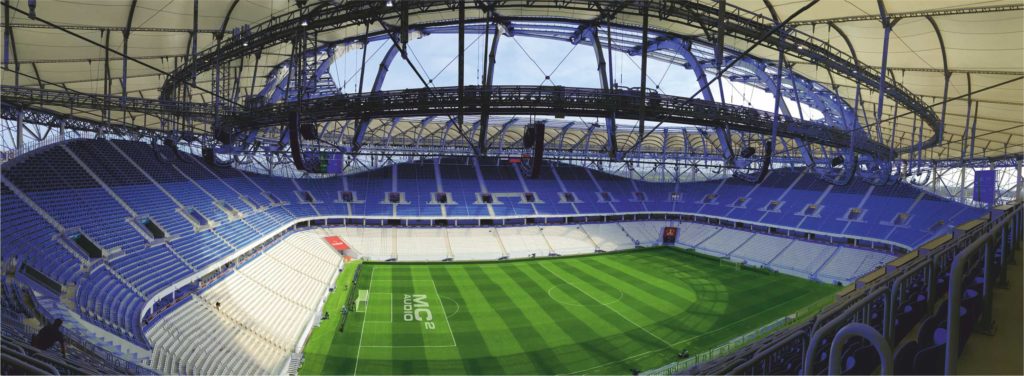
Nice pitch advert…
So France won the tournament. We are fine with that.
Congratulations to France – you played better football.
However, we provided the winning audio power in the Volgograd stadium where England did beat Tunisia and made it through to the quarter finals, and that meant nearly as much to us as winning the entire World Cup!
Let us tell you more about it…
It all started about two years ago – yes really. Much as the Olympics planning is on an 8-12 year cycle, the same holds true of an event the scale of the FIFA World Cup. With the USA-Canada-Mexico combined bid being announced as the winner for the 2026 event, it can be seen that to get the infrastructure in place in time requires years of planning.
Whilst some stadiums and arenas are refitted and remodelled, many are built from scratch, but take advantage of existing roads and transport infrastructure to speed up the process and reduce costs. The Volgograd Arena was one such venue, being built on the site of former FC Rotor’s Central Stadium – demolished in 2014 to make way for the new 45,000 capacity arena, and increasing the number of fans able to watch a match by 40% in the process.
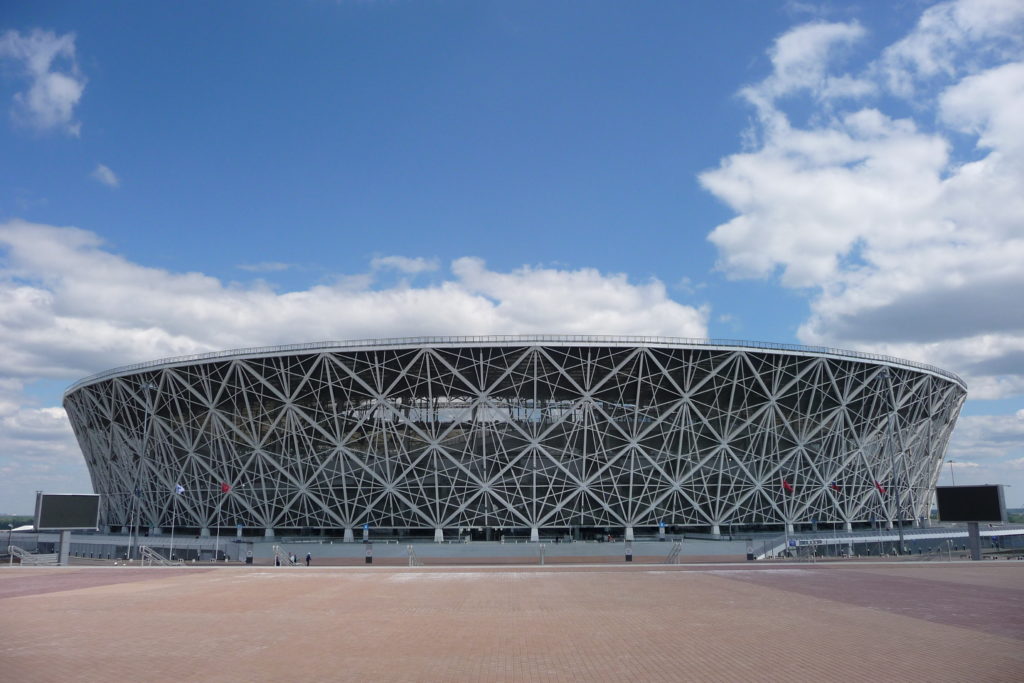
Out with the old, in with the new at Volgograd.
With the World Cup being the focus of the new build arena, FIFA’s input into the design was required. FIFA have very strict regulations about all parts of the specification, from the more obvious aspects such as the crowd control and seating, to the pitch design and lighting. Part of the match experience now encompasses significant video and audio technology, and this is where our story starts.
As the Volgograd Arena was being rebuilt from the ground up, a new bespoke audio system was required to fulfil the needs of a World Cup audience, to meets FIFA’s exacting specification and to provide ongoing sound reinforcement for the future when the Arena was handed back to FC Rotor as their stadium. The proposed finished facility would also serve the city of Volgograd as a venue for concerts, festivals and other sporting and cultural events.
With the deadline of the arena’s completion being non-negotiable (!) the pressure was on to fulfil the requirements for the audio specification of this world-class system. The winning tender for the AV installation came from Edelweiss Audio, based in Moscow. Andrey Kremenchugskiy, Technical Director of the company, explains further:
“We spoke to some partners who suggested we put in a tender. In Russia, the design of any system is done in two stages. Firstly, the preliminary stage, when the main solutions are chosen, the budget is set and acoustic modelling is done, is quite formal. The second stage is when the design work is done and the equipment is specified.”
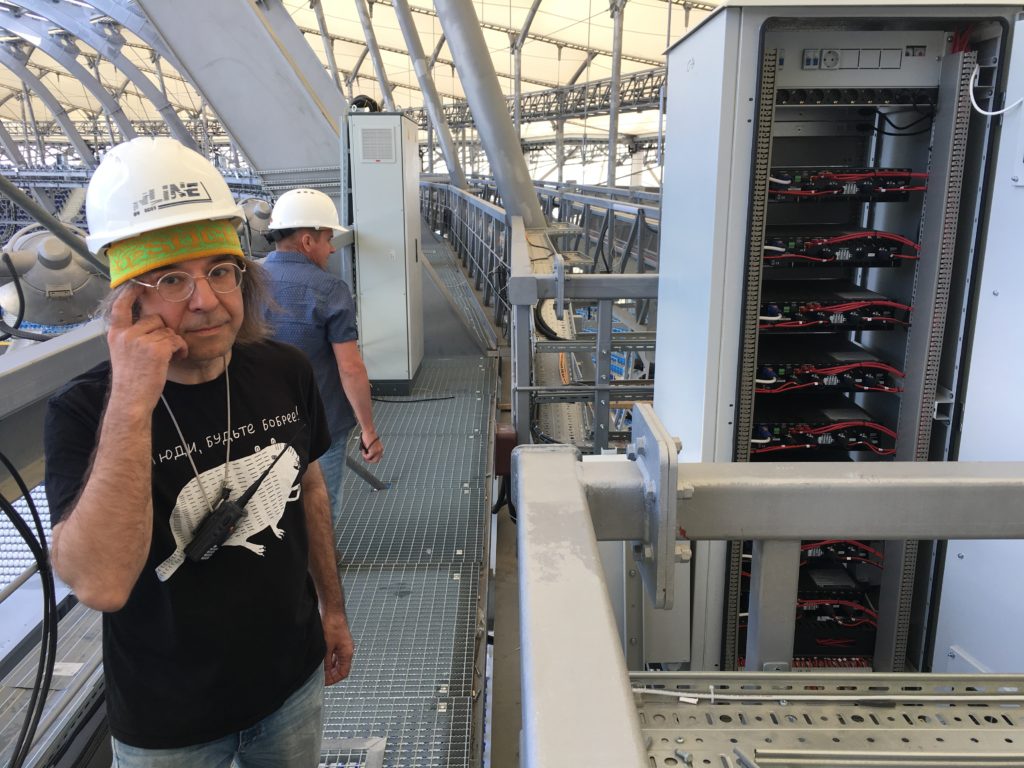
Andrey Kremenchugskiy on his fingerphone
Having won the contract in 2016 to refit the Krasnodar Arena in south-west Russia, and with previous experience at the Sochi Winter Olympics in 2014, Edelweiss Audio has a successful background in AV installs for sport. The additional FIFA specifications meant that audio performance of the system was pushed to the top of the list. With this in mind, Andrey looked to MC2 Audio and Funktion One for the amplification and speaker requirements.
He explains more about this:
” FIFA states that ‘excited football crowds can reach levels of 110dB SPL’, therefore ‘the sound system shall be capable of overcoming the crowd noise by at least 6dB, with deviations in overall sound levels across the spectator area not exceeding +/- 3dB.
In addition to that, the PA system should be capable of having its volume increased in response to crowd noise to ensure intelligibility of voice messaging, a maximum SPL of 125dB should not be exceeded and the frequency response in the seating areas should be at least 120Hz to 5kHz +/- 3dB.
It should also be capable of reproducing music with an extended frequency response between 40Hz and 120Hz +6dB/-3dB and between 5kHz and 12kHz +/-4dB and should provide enough headroom to compensate for atmospheric loss of high frequencies.”
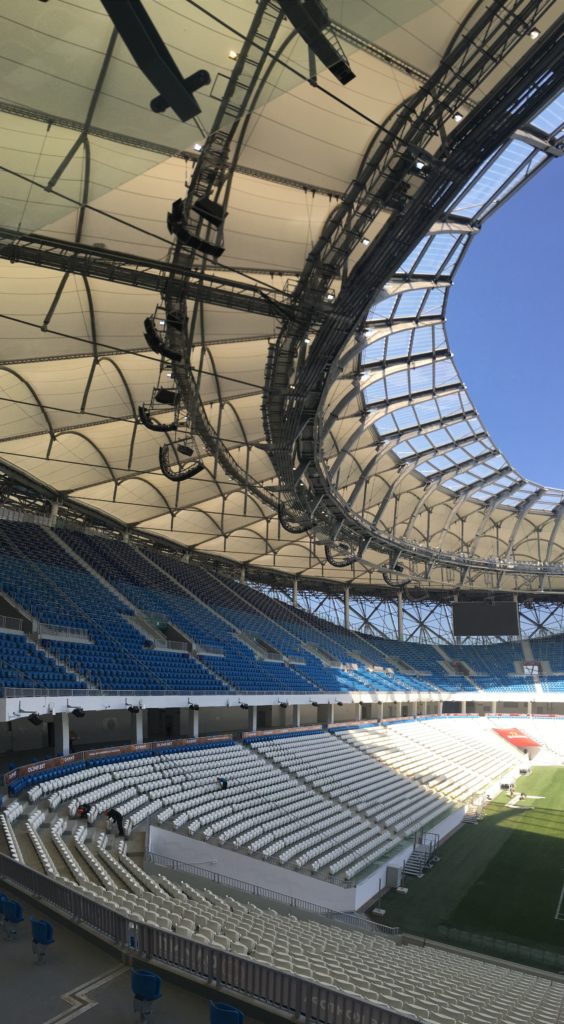
FIFA and 45,000 fans can’t be wrong.
These strict criteria were further qualified by the need for audio to be provided on a digital network connection and for remote monitoring and control to be Ethernet based.
The Delta amplifiers were chosen by Andrey after consultation with Funktion One because of their audio performance and support for network audio and control. There was, however one extra criteria to fulfil, and that was the incredibly tight timescale.
Waring Hayes, Technical Brand Manager for MC2 Audio and XTA, explains how the company coped with this:
“Funktion One have been long-time partners of both brands, and many people will have used their XO Series audio management systems, made by XTA, and their E Series amplifiers, made by MC2. The new DPA series of amplifiers from XTA are the latest design that Funktion One have chosen to become their new “go-to” solution. However, with DPA amplification only being released in the middle of 2017, demand was high, and we wouldn’t have been able to fulfil their substantial order in time.
So we did the only thing we could – we offered them Delta! The Delta Series are based on an identical platform for DSP and power stages, and so ticked all the boxes for Funktion One, FIFA, and Andrey, apart from one – the OEM [Original Equipment Manufacturer] one!”
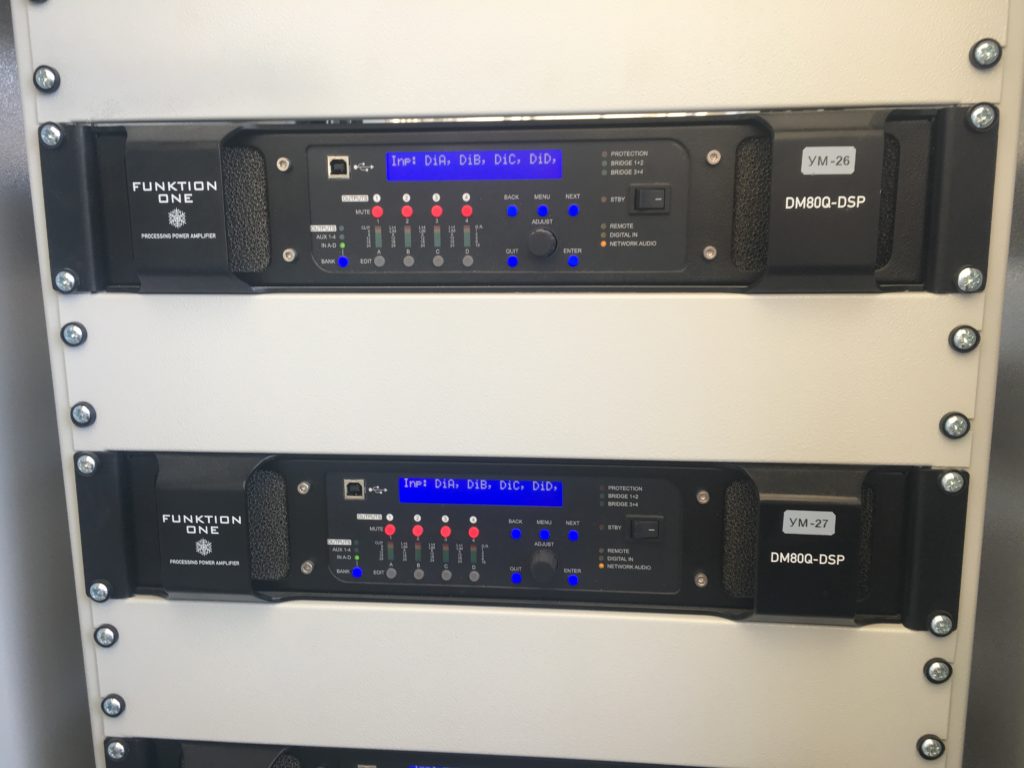
The only time you’ll see this style of Delta amps, anywhere in the world!
As Funktion One had chosen the DPA amplifiers to be their new OEM processing amplifier range, the use of Delta Series amplifiers in this high profile application would prove to be confusing, so it was decided to rebadge them in a one-off version in very simple “DM” livery, with just black and white panels and printing. Apart from the front panel changes, the amplifiers would be standard Delta Series.
And a lot of them. Over 200 channels worth (over 50 amplifiers) totalling close to half a megawatt of power. As all but one of the amplifiers (?!) needed to have processing, the amps were a mix of Delta 80 and Delta 100 DSP models. There was also a mysterious single non-DSP Delta Series amp – fitted with Dante but not required to have remote control…more on that later!
Delta Series have powerful and comprehensive DSP and full audio networking. They also feature four additional aux outputs, running entirely independently of the amplifier channels.
MC2’s Waring Hayes says: “Whilst in this application the four extra aux outputs on each DSP amplifier weren’t required for the live audio, they could easily be used to provide broadcast feeds as they are fully independent of the main amplifier channels and have their own DSP and routing options. They could be thought of as a method of breaking Dante off the network for other uses without any additional cost. Audio can even be routed through them from any source and put back on to the network without the amps ever using it – break in and break out if you will!”
The mysterious single non-DSP amplifier was used for some of the VIP area loudspeakers. Hayes continues: “The non-DSP versions also have the option of a Dante input card – this fits out the amp with 4 x 96k DACs – the same as used to drive the four additional aux outputs of the DSP amps so you can guarantee the same superb audio performance.”
All the DSP amplifiers are connected to a remote PC running AudioCore and are spread across multiple sites throughout the arena – with most amp racks containing eight amplifiers. All amps are equipped with Dante digital network audio, which was used for audio distribution throughout the entire site. This allows the amps to have their input channel sources controlled globally and changed easily without any local re-patching.
Richard Fleming, Sales and Applications Manager at MC2, who was involved in drawing up the amplification requirements and visited the arena during commissioning, explains: “All the amps are connected via Ethernet and configured using our ‘AudioCore: Amped Edition’ software with our killer new feature – grouping architecture.
Kremenchugskiy expands: “The grouping architecture in AudioCore made my life a lot simpler when It came to taking control of the entire system. I was able to create output groups of all tops, and mid sections of all cabs, plus separate control of the subs – ending up with just three control faders. The groups have an additional feature – solo – which enables us to quickly check individual parts of the system.
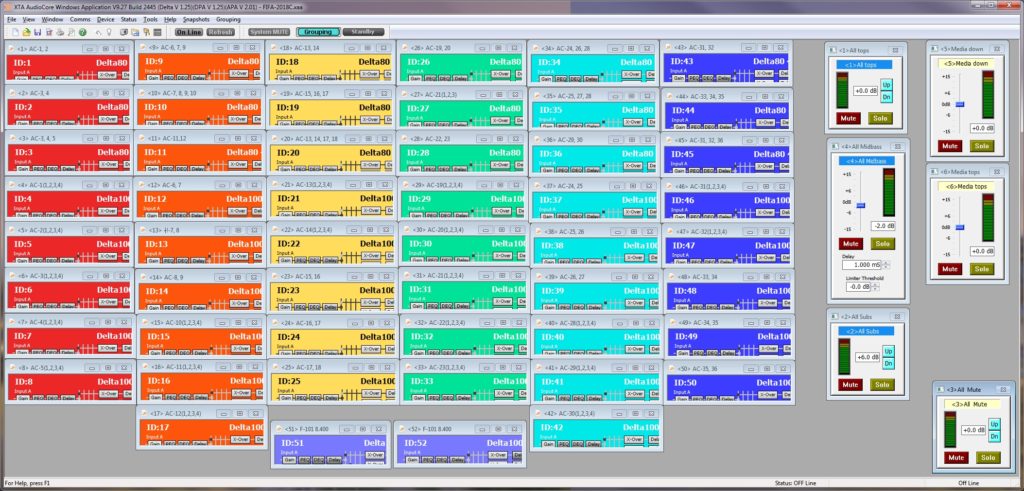
Hugely complex system tamed and simplified down to the groups shown on the right of this AudioCore screenshot.
“By using the input grouping, I could create a single control to adjust selected input channels on each amplifier to have separated control over the media inputs picked off the Dante network. All the output groups have relative gain adjustment so any gain structure already in place between individual elements or across the entire system is maintained if I make changes through the group controls. I also was able to create the most dangerous group of all – the ‘mute all’ group – which controlled over 200 channels of audio.”
With the final speaker count for the system standing at 638 – that’s a lot of drivers and boxes to take care of! The end result is what counts and on the night of the England-Tunisia match, with 35,000 watching in the arena, and in the UK a peak viewing audience of 18.3 million (more than the recent Harry and Megan royal wedding!), the pressure was on, not just for England, but also for the system to perform.
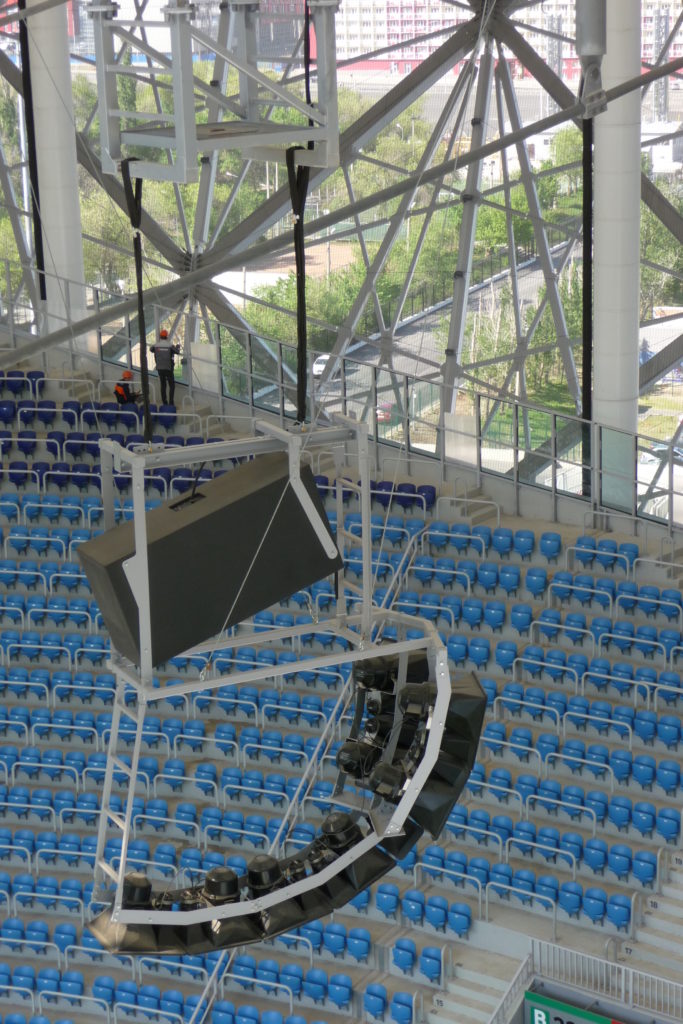
One of the many speaker hangs showing the skeletal Evo based system and flown sub from Funktion One.
It was a brilliant result for the England team and the system, as Dave Bruml of Funktion One is keen to point out:
“The system at Volgograd Arena offers class-leading clarity and intelligibility for voice announcements and delivers impressive and truly immersive full-range musical reproduction to enhance the match-day experience for fans. The sound feels perceptibly close to the audience with an intimacy and accuracy rarely heard from stadia sound systems.”
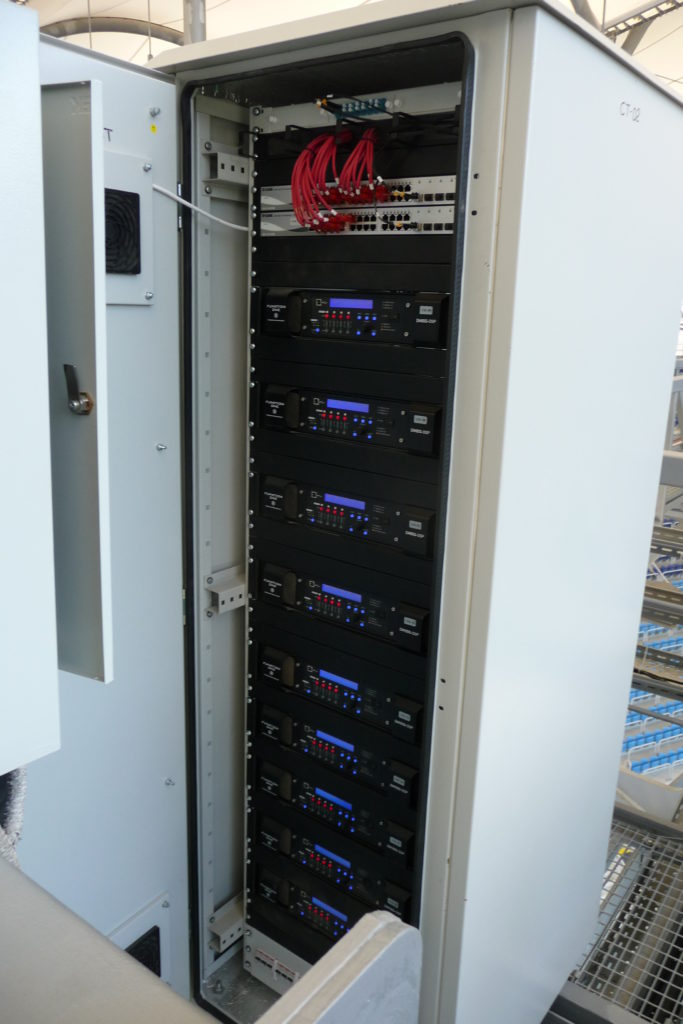
One of many fully loaded amp racks in Volgograd.
The final word must go to Andrey Kremenchugskiy.
“The [Evo] clusters have really strong directivity control – both in the horizontal and the vertical planes. If you run just one cluster, you could clearly hear its zone of coverage. If you walk just a couple of metres outside the coverage pattern, the drop in level is astonishing. You can easily localise the sound to the closest cluster at any seat and overall, we achieved very even coverage.
“The combination of midbass and low-bass enclosures delivers strong overall bass and, once carefully time aligned, combined really well [with Evos]. Due to the high efficiency of these bass loudspeakers, the system response has good balance even at very high SPL levels.”
“The service and support we received from both MC2 [and Funktion One] has been second to none, both during design stage as well as at the final phase of the project, when Richard and Jason [Kelly] from MC2, [as well as staff from Funktion One] came over to Volgograd to help us with tuning of the system.”
Amazing audio performance wasn’t enough for England to bring home the trophy, but at least the legacy left behind will provide FC Rotor with quite possibly the best stadium sound in the whole of Russia!
Download this as a pdf to read off-line.
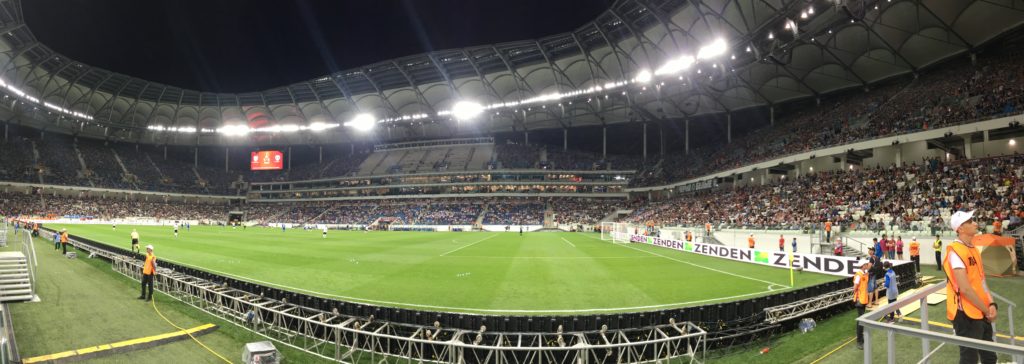
England thrashing Tunisia. Possibly. At least the sound was true…

